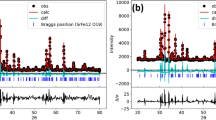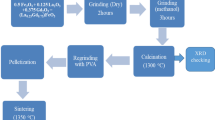Abstract
Measurements of d.c. electrical conductivity were made on 65TeO2-(35 -x)CuO-xLu2O3 (mol%) glasses with x=0, 1, 2, 3, 4. The experimental results show that whenx is changed from 1 to 2 mol%, the conductivity increases due to the additional electrons obtained by the oxidation of TeO2 as well as due to the Cu+ → Cu2+ transition under the effect of interelectronic repulsion in the 4f shell of the lutetium present in the glass. Whenx is increased to greater than 2 mol%, the conductivity decreases because hopping is inhibited due to the formation of oxygen bridge associates or because of the strong ligand repulsive field of lutetium indicating its non-reactivity in the glassy network. The conductivity has a distinct maximum atx=2.
Similar content being viewed by others
References
G. S. Linsley, A. E. Owen andF. N. Hayatee,J. Non-Cryst. Solids 4 (1970) 208.
G. N. Greaves,ibid. 11 (1973) 427.
L. Murawski, C. H. Chung andJ. D. MacKenzie,ibid. 32 (1979) 91.
A. K. Bandyopadhyay andJ. O. Isard,J. Phys. D. 10 (1977) L99.
T. Komiyama, “A study of the glass containing rare earth elements” Reports of Government Industrial Research Institute, Osaka, November 1976.
A. Buri, D. Caferra, F. Branada andA. Marotta,Phys. Chem. Glasses 23 (1982) 37.
A. Makishima, M. Kobayashi andT. Shimohira,J. Amer. Ceram. Soc. 65 (1982) c-210.
R. H. Magruder andD. L. Kinser,J. Non. Cryst. Solids 45 (1981) 389.
N. F. Mott,J. Non-Cryst. Solids 1 (1968) I.
M. N. Khan, Ravishankar Harani, M. M. Ahmad andC. A. Hogarth,J. Mater. Sci. 20 (1985) 2207.
A. E. Mohammed Osman, PhD Thesis, Brunel University, Uxbridge, Middlesex, UK (1987).
G. G. Layne, W. H. Lowdermilk andM. J. Weber,Phys. Rev. 16 (1977) 10.
M. Suleman Malik, C. A. Hogarth andK. A. K. Lott,J. Mater. Sci. Lett. 8 (1989) 1344.
R. Mancaster andS. Parke,J. Non-Cryst. Solids 24 (1977) 399.
V. K. Dhawan, A. Mansingh andM. Sayer,ibid. 51 (1982) 87.
B. W. Flynn andA. E. Owen,J. Physique Proceedings 9th International Conference on Amorphous and Liquid Semiconductors 11”, edited by B. K. Chakraverty (France, 1981) p. C4–1005
G. F. Liptrot, “Modern Inorganic Chemistry” 3rd edn, (Bel and Hayman, London, 1981) pp. 436, 439.
H. L. Smith andA. J. Cohen,Phys. Chem. Glasses 4 (1963) 173.
B. N. Figgis, “Introduction to the Ligand Field” (Wiley, London, 1966) p. 327.
Ravishankar Harani andC. A. Hogarth,J. Mater. Sci. Lett. 5 (1986) 492.
Author information
Authors and Affiliations
Rights and permissions
About this article
Cite this article
Malik, M.S., Hogarth, C.A. Chemical approach to the conduction mechanism in copper tellurite glasses containing lutetium oxide. J Mater Sci 25, 1913–1916 (1990). https://doi.org/10.1007/BF01045742
Received:
Accepted:
Issue Date:
DOI: https://doi.org/10.1007/BF01045742




